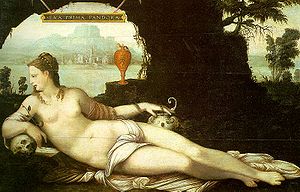
Jean Cousin the Elder
Encyclopedia


Career
Cousin began his career in his native town with the study of glass-painting under Jean Hympe and Grassot. At the same time, he studied mathematics and published a successful book on the subject. He also wrote on geometry in his student days. In 1530 Cousin finished the windows for Sens Cathedral, the subject chosen being the "Legend of St. Eutropius". He also painted the windows of many of the noble châteaux in and around the city. The latest date on any of his Sens work, 1530, points to this as the year he went to Paris, where he began work as a goldsmith; but the amount and kind of his productions in the precious metals are alike unknown.In Paris Cousin continued his career as a glass-painter, and created his best-known work, the windows of the Sainte-Chapelle in Vincennes
Vincennes
Vincennes is a commune in the Val-de-Marne department in the eastern suburbs of Paris, France. It is located from the centre of Paris. It is one of the most densely populated municipalities in Europe.-History:...
. He subsequently devoted himself to painting in oil, and has been claimed as the first Frenchman to use that new medium. Pictures attributed to him, all of much merit, are found in several of the large European collections, but, excepting "The Last Judgment", none is known to be authentic. For a long time this work lay neglected in the sacristy
Sacristy
A sacristy is a room for keeping vestments and other church furnishings, sacred vessels, and parish records.The sacristy is usually located inside the church, but in some cases it is an annex or separate building...
of the church of the Minims, Vincennes, until it was rescued by a priest and transferred to the Louvre. It is said to be the first French picture to be engraved.
He was also an illustrator of books, making many designs for woodcut
Woodcut
Woodcut—occasionally known as xylography—is a relief printing artistic technique in printmaking in which an image is carved into the surface of a block of wood, with the printing parts remaining level with the surface while the non-printing parts are removed, typically with gouges...
s and often executed them himself. The "Bible", published in 1596 by Le Clerc, and the Metamorphoses
Metamorphoses (poem)
Metamorphoses is a Latin narrative poem in fifteen books by the Roman poet Ovid describing the history of the world from its creation to the deification of Julius Caesar within a loose mythico-historical framework. Completed in AD 8, it is recognized as a masterpiece of Golden Age Latin literature...
and Epistles
Epistulae ex Ponto
Epistulae ex Ponto is a work of Ovid, in four books. It is especially important for our knowledge of Scythia Minor in his time....
of Ovid
Ovid
Publius Ovidius Naso , known as Ovid in the English-speaking world, was a Roman poet who is best known as the author of the three major collections of erotic poetry: Heroides, Amores, and Ars Amatoria...
(1566 and 1571 respectively) contain his most noted work as an illustrator. Cousin etched and engraved many plates after the manner of Parmigianino
Parmigianino
Girolamo Francesco Maria Mazzola , also known as Francesco Mazzola or more commonly as Parmigianino or sometimes "Parmigiano", was an Italian Mannerist painter and printmaker active in Florence, Rome, Bologna, and his native city of Parma...
, to whom the invention of etching has been ascribed. He also created sculptures, including, it is thought, the mausoleum of Admiral Philippe de Chabot
Philippe de Chabot
Philippe de Chabot, Seigneur De Brion, Count of Charny and Buzançois , also known as Admiral De Brion, was an admiral of France.- Biography :...
. In addition to his early writings on mathematics, he published, in 1560, a treatise on perspective
Perspective (graphical)
Perspective in the graphic arts, such as drawing, is an approximate representation, on a flat surface , of an image as it is seen by the eye...
, and, in 1571, a work on portrait-painting. During his life Cousin enjoyed the favour of and worked for four kings of France: Henry II, Francis II, Charles IX, and Henry III. Among his paintings, mention should also be made of the miniatures in the prayer book of Henry II now in the Bibliothèque Nationale; among his etchings and engravings, the Annunciation and the Conversion of St. Paul; among his woodcuts, the Entrée de Henry II et Catherine de Médicis à Rouen (1551; book available here).
Sources
cites:-
- FIRMIN-DIDOT, Etude sur Jean Cousin (Paris, 1872);
- PATTISON, The World's Painters since Leonardo (New York, 1906)
External links
- The Last Judgement, with citation in French

